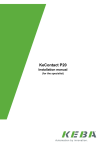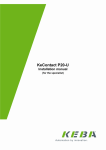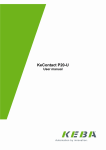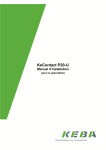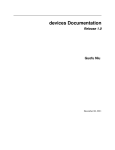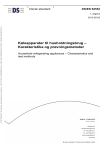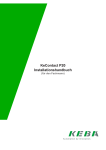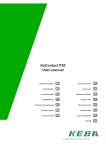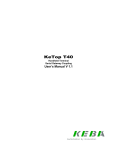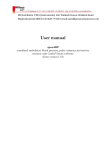Download KeContact P20 Installation manual
Transcript
KeContact P20
Installation manual
(for the specialist)
Comments to this manual
In this manual you will find warnings against possible dangerous situations. The used symbols apply to the
following meanings:
WARNING!
Indicates a potentially hazardous situation which, if not avoided could result in death or se
rious injury.
CAUTION!
Indicates a potentially hazardous situation which, if not avoided may result in minor or
moderate injury.
ATTENTION
Indicates a situation which, if not avoided could result in property damage.
ESD
This symbol reminds you of the possible consequences of touching electrostatically sensi
tive components.
Notice
Notes on use of equipment and useful practical tips are identified by “i". Notices do not contain any
information that draws attention to potentially dangerous or harmful functions.
Additional important information.
This icon marks steps of a sequence of operations.
Document: V 2.00
Document no.: # 90064
Pages: 48
(C) KEBA AG 20122015
Specifications are subject to change due to ongoing technical development. No guarantee is offered in respect of any of the specifica
tions given here. All rights reserved.
All intellectual property, including trademarks and copyrights, are the property of their respective owners. Any unauthorized use
thereof is strictly prohibited.
KEBA AG, Postfach 111, Gewerbepark Urfahr, A4041 Linz, www.kecontact.com
The device bears the CE mark.
The declaration of conformity is being held by KEBA AG.
The device meets the ROHS directive (RL 2011/65/EU).
The declaration of conformity is being held by KEBA AG.
Information on disposal
The symbol with the crossedout garbage can points out that electrical and electronic devices
including their accessories should not be disposed of in the household garbage. Information on
correct disposal can be found on the product itself, in the instructions for use or on the packag
ing.
Depending on their coding, the raw materials are recyclable. By disposing of such used devices
correctly, you can ensure that they can be reused, their raw materials recycled or put to another
use, and you will be making an important contribution to the protection of our environment.
Disposal of batteries
Batteries or rechargeable batteries are hazardous waste and must be disposed of in the correct
manner. Although batteries have a low voltage, in the event of a shortcircuit, they can still emit
a charge sufficient to ignite flammable materials. Batteries should therefore not be disposed of
together with conductive materials (such as iron filings, wire wool contaminated with oil etc.).
You can download the KeContact P20 Installation Manual on the Internet at www.kecontact
.com.
You can download the latest KeContact P20 Firmware on the Internet at www.kecontact.com
(download area).
A new firmware can take into account modified standards or improve the compatibility to new
electric vehicles, for example.
3/48
Contents
Contents
1
2
Important information ............................................................................................................. 6
1.1
Safety information .......................................................................................................... 6
1.2
Intended use .................................................................................................................. 8
1.3
About this manual .......................................................................................................... 8
1.4
Product description ........................................................................................................ 9
Variant overview.................................................................................................................... 10
2.1
3
Installation guidelines........................................................................................................... 12
3.1
General criteria for the site selection ........................................................................... 12
3.2
Specifications for the electrical connection .................................................................. 13
3.3
4
General ......................................................................................................... 13
3.2.2
Differing requirements for compliance with "Z.E.Ready®" (Renault) .......... 14
Space requirements..................................................................................................... 15
4.1
Installation requirements.............................................................................................. 17
4.2
Preparing the housing.................................................................................................. 18
4.2.1
Removing the housing cover ........................................................................ 18
4.2.2
Removing the connector panel cover ........................................................... 19
Preparing the cable insertion ....................................................................................... 20
4.3.1
Cable insertion from above surface cable routing ...................................... 20
4.3.2
Cable insertion from behind flushmounted cable routing .......................... 21
4.4
Mounting the charging station...................................................................................... 22
4.5
Electrical connection .................................................................................................... 25
4.5.1
Connection overview with opened connector panel cover............................ 25
4.5.2
Connecting the power supply line ................................................................. 26
4.5.3
Enable input [X1] (excluding eseries) .......................................................... 29
4.5.4
Switch contact output [X2] (excluding eseries) ............................................ 30
4.5.5
Terminals [X1/X2] (excluding eseries) ......................................................... 31
4.5.6
Ethernet1 connection [ETH] (optional).......................................................... 32
4.6
DIP switch settings....................................................................................................... 34
4.7
Commissioning ............................................................................................................ 37
4.7.1
Commissioning mode/self test ...................................................................... 37
4.7.2
Safety checks ............................................................................................... 38
4.7.3
Mounting the housing cover.......................................................................... 39
Additional technical instructions......................................................................................... 40
5.1
4/48
3.2.1
Installation ............................................................................................................................. 16
4.3
5
Optional equipment...................................................................................................... 10
Programming RFID user cards (optional) .................................................................... 40
Contents
5.2
Configuring the communication with the electric vehicle PLC>Ethernet (optional)..... 41
5.3
Replacing the fuse ....................................................................................................... 41
5.4
Dimensions .................................................................................................................. 42
5.5
Technical data.............................................................................................................. 43
5.6
Standards and regulations ........................................................................................... 45
Index ....................................................................................................................................... 46
5/48
Important information
1
Important information
1.1
Safety information
WARNING!
Not observing the safety instructions can result in risk of death, injuries, and damage to the
device! KEBA AG assumes no liability for claims resulting from this!
●
Electrical hazard!
The installation, commissioning and maintenance of the charging station may only be
performed by correctly trained, qualified and authorized electricians (1) who are fully re
sponsible for the compliance with existing standards and installation regulations.
Please observe that an additional overvoltage protection can be required by vehicles or
national regulations.
Also observe that some countries or vehicle manufacturers may require a different trig
gering characteristic of the faultcurrent circuit breaker (Type B).
●
Only connect voltages and circuits in the righthand connection area (Ethernet, termi
nals for control lines) that have a secure separation to dangerous voltages (e.g. suffi
cient isolation).
Only supply the terminals (X2) from voltage sources which have safety extralow volt
age!
(1)
●
Before commissioning, check all screw and terminal connections for tightness!
●
The connector panel cover may never be left open unattended. Mount the connector
panel cover if you leave the charging station.
●
Do not carry out any unauthorized conversion work or modifications to the charging
station!
●
Repair work to the charging station is not permitted and may only be performed by the
manufacturer (replacement of the charging station)!
●
Do not remove any notices on the device, such as safety symbols, warning notices, rat
ing plates, nameplates or cable markings!
●
The charging station does not have its own power switch! The FI circuit breaker and the
line circuit breaker of the building installation serve as mains disconnector.
●
Pull the charging cable out of the plug connection by the plug only and not by the cable.
●
Make sure that the charging cable is not damaged mechanically (kinked, pinched or
driven over) and do not allow the contact area to come into contact with sources of
heat, dirt or water.
Persons who, due to their special training, expertise and experience as well as knowledge of current stan
dards, are able to assess the work performed and the possible hazards.
6/48
Important information
ATTENTION
Risk of damage!
●
Make sure that the charging station is not damaged by improper handling (anchoring,
housing cover, socket, inner parts etc.).
●
Do not open the connector panel cover in the rain!
●
Risk of breaking the plastic housing!
Countersunk screws may not be used for the mounting!
The included washers must be used.
Do not tighten the mounting screws with force.
The mounting surface must be completely level (max. 1 mm difference between the
support points or mounting points). Warpage of the housing must be prevented.
ESD
Information for technicians who are permitted to open the device:
Risk of damage! Electronic components can be destroyed if touched!
●
Before handling the modules, touch a grounded metal object in order to discharge any
static electricity from your body.
CAUTION!
5 safety rules:
Shut down all poles and all sides!
Secure against reactivation!
Check that the equipment is voltagefree!
Provide earthing and shortcircuit protection!
Cover adjacent live parts and restrict access to hazardous areas!
7/48
Important information
1.2
Intended use
The device is a "charging station" for the indoor and outdoor area at which electrically operated vehicles can
be charged (e.g. electric automobiles).
The charging station is designed for installation on a wall or in a floormounted column.
The respective national regulations must be observed with regard to the installation and connection of the
charging station.
The intended use of the device always includes the compliance with the environmental conditions for which
this device was developed.
The device was developed, manufactured, inspected and documented in compliance with the relevant safety
standards. Therefore, the products do not pose any danger to the health of persons or a risk of damage to
other property or equipment under normal circumstances, provided that the instructions and safety precau
tions relating to the intended use are properly observed.
The instructions contained in this manual must be precisely followed in all circumstances. Failure to do so
could result in the creation of potential sources of danger or the disabling of safety devices. Apart from the
safety instructions given in this manual, the safety precautions and accident prevention measures appropri
ate to the situation in question must also be observed.
Only electrical vehicles or their chargers may be connected. The connection of other devices (e.g. electric
tools) is not allowed!
Due to technical or legal restrictions, not all versions/options are available in all countries.
1.3
About this manual
This manual is valid for devices of the type:
●
KeContact P20
Use of this manual
This installation manual is intended for qualified personnel(1) only.
The figures and explanations contained in this manual refer to a typical device design. The design of the de
vice may deviate from it.
Please refer to the "KeContact P20 User Manual" for information and instructions about operating the device.
(1)
Persons who, due to their special training, expertise and experience as well as knowledge of current stan
dards, are able to assess the work performed and the possible hazards.
8/48
Important information
1.4
Product description
Example KCP20ES240030000xxxx
Product description
Model plate
See top on the device
Product family
KC
KeContact
Product type
P
Charge Point
Type / Version
20
Type
Design versions
Basic versions
E
E…Europe
Cable / Socket
S
S…Socket C…Cable
2
1…Type 1
2…Type 2
S…Shutter
4
1…13A
2…16A
3…20A
4…32A
00
00…no cable
01…4m straight
04…6m straight
99…4m spiraled
Electronics
3
0...eseries
1...bseries
2...cseries
3...cseries + PLC
Electrics
0
0…protection / 1…protection 1phase
Options
Key Left
0
Key right
0
Authentication
0
0…not populated
0…not populated
R…RFID
K…Key switch
Optional customer code
2digit
xx
9/48
Variant overview
2
Variant overview
Base model with socket (Type 2)…
[A]…Status LED
[B]…Standard socket (variants possible)
[C]…Housing cover
Base model with charging cable Type 1, Type 2)…
[A]…Status LED
[B]…Parking bay for charging connector
[C]…Housing cover
[D]…Bracket for charging cable
Storing the charging connector/charging cable…
If no charging procedure is being performed, the charg
ing connector can be plugged into the parking bay [B]
for safe storage.
The charging cable can be coiled up and placed on the
hanger [D].
2.1
Optional equipment
RFID sensor
The RFID sensor [R] is used for touchless authoriza
tion of a user with MIFARE cards or tags according to
ISO14443.
10/48
Variant overview
Key switch
The key switch [S] is used for authorizing a user.
Additional optional equipment
●
Network capability
●
Switch contact (for control of external additional equipment)
●
Enable input for e.g. ripple control receivers, time switches,…
(This permits a scheduled (timecontrolled) charging of the vehicle to be realized.)
●
PLC (Power Line Communication) according to GreenPhy standard
●
Mounting column
11/48
Installation guidelines
3
Installation guidelines
3.1
General criteria for the site selection
The charging station was constructed for the indoor and outdoor area. Accordingly it is necessary to ensure
the installation conditions and the protection of the device at the installation site. ●
Take into account the local electrical installation regulations, fire prevention measures and accident pre
vention regulations as well as emergency routes at this site.
●
The charging station may not be installed in potentially explosive zones (Ex environment).
●
Mount the charging station so that it is not located in the direct flow of passersby and so that no one can
trip over connected charging cables and so that the charging cables do not cover or cross passing
pedestrian and motorized traffic.
●
Do not install the charging station at locations where ammonia or ammonia gas is exposed (e.g. in or at
stables).
●
The mounting surface must be sufficiently stable in order to withstand the mechanical forces.
●
Do not install the charging station at locations where falling objects could damage the device (e.g. hung
up ladders or automobile tires).
●
According to product standard, the charging station must be located at a height between 0.4 m and 1.5
m.
We recommend mounting the charging station (height of the socket or parking bay) at a height of 1.2 m.
Observe that national regulations can limit this height.
●
The device may not be exposed to direct spray water (e.g. neighboring manual carwash facility, high
pressure cleaner, garden hose).
●
The device should be protected against direct rain as far as possible to prevent icing, hail damage or
similar.
●
The device should be mounted protected from direct sunlight as far as possible to reduce the charging
current or the interruption of the charging due to excessive temperatures of the components of the
charging station.
●
When set up unprotected against the weather (e.g. outside at a parking space), the charging current
specification is reduced to 16A if the maximum permitted temperature is exceeded. The charging proce
dure can also subsequently be switched off.
For information about environmental conditions, please refer to the "5.5 Technical data" chapter.
Observe the internationally valid installation standards (e.g. IEC 603641 and IEC 60364552) and
comply with the nationally applicable installation standards and regulations.
12/48
Installation guidelines
3.2
Specifications for the electrical connection
3.2.1
General
The charging station is set to 10 amps in the delivery state. Set the maximum current using the DIP
switches to match the installed circuit line breaker (see Chapter "4.6 DIP switch settings").
The power supply line must be hardwired to an existing house installation and correspond to the nationally
applicable legal conditions.
Selection of the faultcurrent circuit breaker (FI):
●
Every charging station must be connected via its own FI. No other circuits may be connected to this FI.
●
Ground fault circuit interrupters of at least type A. If the vehicles to be charged are not known (e.g. semipublic area), measures must be met for protection
where direct fault currents (>6mA) occur. This can be realized, for example, through the use of an FI
type specifically intended for electric vehicles or with a FI type B. The vehicle manufacturer specifica
tions must also be observed.
●
The nominal current IN must be selected to match the circuit breaker and fuse.
Dimensioning of the circuit line breaker:
When dimensioning the circuit line breaker also observe the increased environmental temperatures inside
the switch cabinet! Under certain circumstances, this can make a reduction of the charging current specifica
tion necessary in order to increase the system availability.
●
Determine the nominal current according to the type plate specification in coordination with the desired
charging capacity (DIP switch settings for charging current specification) and the power supply line.
Dimensioning of the power supply line:
When dimensioning the power supply line also observe the possible reduction factors and the increased en
vironmental temperatures in the interior connection area of the charging station (see temperature rating of
the supply terminals)! Under certain circumstances, this can lead to an increase of the cable crosssection
and to the adaptation of the temperature resistance of the power supply line.
Mains disconnector:
The charging station does not have its own power switch. The FI circuit breaker and the line circuit breaker
of the power supply line serve as mains disconnector.
13/48
Installation guidelines
3.2.2
Differing requirements for compliance with "Z.E.Ready®" (Renault)
●
For the case where the internal switching element (contactor) is no longer able to open, an additional
switchoff capability must be realized. This can be realized with the switch contact output X2 (for details,
see Chapter "4.5.4 Switch contact output [X2] (excluding eseries)").
●
No 13A charging cables may be used.
●
For 3phase connection of the KeContact P20, at least a faultcurrent circuit breaker (FI) type A with DC
fault current detection (>6mA) or a faultcurrent circuit breaker (FI) type B must be used.
●
Renault recommends selecting the faultcurrent circuit breaker according to the following table:
Charging current speci
fication (DIP switch setting)
Circuit line breaker
Characteristic
1phase
10A
not allowed!
13A
not allowed!
3phase
16A
20A
C
D
20A
25A
C
D
25A
32A
C
D
32A
32A
B
C
The nominal current of the selected circuit line breaker may never exceed the specifications on the
type plate. If the current specification and nominal current of the circuit line breaker are equal, the
temperature in the switch cabinet must be specifically observed (thermal derating of the circuit line
breaker).
Mains supply requirements
●
In TT and TN networks, the grounding resistance of the system must be less than 150 Ohm.
●
In IT or TT networks with a grounding resistance greater than 150 Ohm, an isolating transformer must
be installed before the EVSE (Electric Vehicle Supply Equipment) installation. The isolating transformer
must then be integrated into a TN grounding system, applicable for the abovestated criteria.
●
Power supplies with IT grounding systems are forbidden.
●
In TT and TN networks, the voltage at the N line to PE may not be higher than 10 V.
●
An excessive fraction of harmonic waves can cause termination of the charging procedure. The public
mains power supply should fulfill the standards IEC 6100021, IEC 6100022, EN 50160 § 4.2.4 and §
4.2.5 to prevent this problem. The maximum permitted limit of harmonic waves can vary in dependence
on the mains network impedance.
14/48
Installation guidelines
3.3
Space requirements
Space requirement…
For device versions with optional cable hanger, addi
tional free area y for the charging cable to be used is
to be accounted for.
If several charging stations are installed adjacent to
each other, a distance of at least 200 mm between
charging stations must be complied with.
Dimensions in millimeters
15/48
Installation
4
Installation
Scope of delivery
eseries
Others
Charging station
1 pieces
1 pieces
Cable hanger (for versions with charging cable)
1 pieces
1 pieces
Installation manual (for the specialist)
1 pieces
1 pieces
User manual (for the end customer)
1 pieces
1 pieces
Drilling template
1 pieces
1 pieces
Keys for cylinder lock (optional)
3 ST
RFID card (optional)
1 pieces
[1] Cable gland M32x1.5, black (clamping area 10–21mm)
1 pieces
1 pieces
[2] Locknut M32x1.5 black
1 pieces
1 pieces
[3] Cable gland M16x1.5 black (clamping area 4–10mm)
1 pieces
[4] Locknut M16x1.5 black
1 pieces
[5] Doublemembrane seals M32 black (clamping area 14–21mm)
1 pieces
1 pieces
[6] Doublemembrane seals M20 black (clamping area 7–12mm)
1 pieces
[7] Reduction insert M32/M20 grey
1 pieces
[12] Cable gland M20 grey
1 pieces
Mounting set for wall insulation:
[8] Anchors for M8; Fischer UXR8
4 pieces
[9] Hangar bolts M8x100
4 pieces
[10] Nut ISO 10511 M8
4 pieces
[11] Washer ISO 7089 8.4
8 pieces
Supplied installation materials
16/48
Installation
4.1
Installation requirements
●
Before beginning the installation, the installation guidelines must be observed.
●
Contact person onsite (for access to the mains disconnector in the electrical distribution panel board).
●
The electrical connection (power supply line) must be prepared.
●
Acclimatization
For a temperature difference of more than 15°C between transport and installation site, the charging sta
tion should be allowed to acclimate unopened for at least two hours.
Opening the charging station immediately can cause water to form inside and lead to damage when the
device is switched on. Under certain circumstances, this damage may not occur until a later point after
the installation.
In the ideal case, the charging station should be stored at the installation side for several hours prior to
installing. If this is not possible, the charging station should not be stored outside with cold temperatures
(< 5°C) overnight or stored in a vehicle.
Tool list for KCP20
The following tools are required for the installation:
●
Flathead screwdriver for supply terminals (blade width 5.5 mm)
●
Flathead screwdriver for terminals X1/X2 (blade width 3.0 mm)
●
Phillips head screwdriver PH2
●
Mounting tools for cable screw connections M16 (width across flats 20 mm) and M32 (width across flats
36 mm)
●
LSA+ insertion tool (optional)
17/48
Installation
4.2
4.2.1
Preparing the housing
Removing the housing cover
Cover screws…
Unscrew the two cover screws [S] on the bottom
side of the housing cover.
Removing the housing cover…
(1) Pull the housing cover down slightly.
(2) Slide the housing cover up slightly to unhinge it.
18/48
Installation
4.2.2
Removing the connector panel cover
Removing the connector panel cover…
Unscrew the four screws that mount the connector
panel cover and remove the connector panel cover.
Take the silica bag out of the terminal panel and
dispose of it properly.
Information for subsequent assembling
Mounting the connector panel cover…
Insert the connector panel cover again.
Mount the connector panel cover again using the
four screws.
Enclosure marking…
Tighten the 4 screws until the enclosure marking on
the connector panel cover is flush with the enclo
sure.
The connector panel cover must seal the enclosure
properly.
Selftapping screws require more force (min. 2.5
Nm to max. 5 Nm).
19/48
Installation
4.3
Preparing the cable insertion
There are two possibilities available for the cable insertion: ●
Cable insertion from above (surface cable routing)
●
Cable insertion from below (flushtype cable routing)
Preparations
Remove the connector panel cover (see Chapter "4.2.2 Removing the connector panel cover").
Fit the charging station with the required cable glands or dummy screw fittings (if an open cable
insertion opening is no longer used).
Breaking out the cable insertion openings…
Place the housing on a stable support pad and use
a hammer and flathead screwdriver to carefully
break out the required cable insertion openings.
Then insert the corresponding feedthroughs (cable
gland or doublemembrane seals)
4.3.1
Cable insertion from above surface cable routing
A ... Cable gland M32 (power supply line)
C ... Cable gland M16 (for control line/Ethernet)
20/48
B ... Cable gland M16 (for control line/Ethernet)
...
Installation
4.3.2
Cable insertion from behind flushmounted cable routing
A ... Feedthrough/doublemembrane seals M32
(power supply line)
B ... Feedthrough/doublemembrane seals M20 (for
control line/Ethernet)
C ... Feedthrough/doublemembrane seals M20 (for
control line/Ethernet)
...
Make sure that the connection cable is inserted through the center of the doublemembrane seal
to ensure seal tightness.
Cable outlet flushmounted box…
A double flushmounted box with separating divider for
secure separation can be provided for the cable inser
tion.
[A]… Power supply line
[B]… Control line
[C]… Ethernet
21/48
Installation
4.4
Mounting the charging station
Installation materials
The included installation material (excluding eseries) is suitable for cement, brick and wood (without an
chors). For other surfaces, a suitable method of installation must be selected.
Depending on the device model or for special materials, the installation materials must be provided
by the customer. A proper installation is absolutely necessary and lies outside of the scope of re
sponsibility of the KEBA AG.
Please also observe the following manufacturer instructions:
Instructions for placing anchors and bolts. Source: Fischer
Marking the holes…
Mark the four holes [1] to [4] using the supplied
drilling template and a spirit level.
Drill the four mounting holes.
Information about the drilling template:
● The drilling template shows the outer contour of
the charging station.
22/48
●
The four main mounting holes are aligned centered
to the slotted holes on the device.
●
The three holes in the upper right show the area
for the cable insertions and help to be able to align
the mounting position of the device to the cables.
●
The two notches on the top side are used for align
ing the device to the connection lines.
●
In the lower part, the holes for the optional cable
hanger can be drilled appropriate to the device.
This part can be separated if the cable hanger is
not mounted or is to be mounted at a different lo
cation.
Installation
Water drainage…
The water drainage from the top side to the rear side of
the charging station must be ensured. Therefore, ob
serve the following:
●
Only a vertical installation of the charging station is
permitted.
●
The charging station must be mounted at an angle
of 90° (no inclination is permitted!).
Mounting the charging station…
Turn the hanger bolts into the anchors until the
thread still protrudes approx. 2 cm ('x').
Use the shims [A] to compensate for any uneven
ness and to ensure a water drainage behind the de
vice.
Position and mount the charging station using the
supplied washers and nuts.
[A]…Shim
[B]…Charging station housing
[C]…Washer
[D]…Nut
23/48
Installation
Installation on hollow walls…
For installation on hollow walls, at least 2 mounting
screws must be secured to a support element of the
wall (see figure).
Special hollowwall anchors must be used for the other
mounting screws.
When installing on hollow walls you must ensure that
the bearing strength of the construction is sufficient.
24/48
Installation
4.5
Electrical connection
4.5.1
Connection overview with opened connector panel cover
1 ... Mains connection phase conductor 1
2 ... Mains connection phase conductor 2
T1 ... Service button
LED ... Status LED (internal)
3 ... Mains connection phase conductor 3
X1 ... Enable input
N ... Mains connection N wire
X2 ... Switch contact output
PE ... Mains connection PE wire
X3 ... Ethernet2 connection (debug)
F1 ... Fuse holder
X4 ... Ethernet1 connection (LSA+ terminals)
DSW1 ... DIP switch configuration
DSW2 ... DIP switch addressing
Gnd ... Ground for Ethernet connection terminals
...
25/48
Installation
4.5.2
Connecting the power supply line
Running the power supply line (surface cable rout
ing)…
Run the supply line from ABOVE as shown in the
figure.
[M]… Cable sheathing
Running the power supply line (flushtype cable
routing)…
The power supply cable must be run as shown
through the feedthrough/doublemembrane seal
[DMS].
Make sure that the doublemembrane seal fits
cleanly against the cable sheathing.
Please observe:
●
Use of a suitable cable sheathing diameter of the supply line or increase of the cable sheathing diameter
by means of suitable seal adapter (see list "Scope of supply" for details about the terminal range).
●
Feed the supply line (feed line from above) resp. doublemembrane seals (feed line from behind) suffi
ciently into the cable gland. The cable sheathing must be visible in the connection area.
●
The installation pipe or cable conduit with the feed line may not be screwed together in the cable gland
(feed line from above) or run through the doublemembrane seals (feed line from behind).
●
The feed line must be run straight through the cable gland (feed line from above) resp. the doublemem
brane seals (feed line from behind), in compliance with the bending radii (approx. cable diameter times
10).
●
The cable gland resp. doublemembrane seals must be installed properly and screwed together suffi
ciently.
26/48
Installation
Connecting the power supply line…
Shorten the connection wires to the appropriate
length; these should be kept as short as possible.
The PE conductor must be longer than the remain
ing conductors!
Strip approx.12 mm from the connection wires.
Coreend sleeves are recommended for fine
stranded wires.
Perform the connection of the power supply line
[L1], [L2], [L3], [N] and [PE].
Observe which phase conductor you connect to ter
minal [L1] if several charging stations are installed
in a network (DIP switch settings for load manage
ment).
1phase connection…
It is also possible to connect the charging station with
only 1phase; the terminals [L1], [N] and [PE] are to be
used for this.
Supply terminals…
The supply terminals are designed as springtype ter
minals.
Insert the flathead screwdriver (5.5 mm) into the
power supply terminal as shown in the figure.
Terminal data:
Fixed (min.max): 0.2 – 16 mm²
Flexible (min.max): 0.2 – 16 mm²
AWG (min.max): 24 – 6
Flexible (min.max) with wire end sleeve:
Without/with plastic sleeve
0.25 – 10 / 0.25 – 10 mm²
Insulation stripping length: 12 mm
Flathead screwdriver 5.5 mm
ATTENTION
Risk of breaking the terminal!
●
Do not press the screwdriver up, down or to the side!
27/48
Installation
Opening the power supply terminal…
Using moderate force, press the screwdriver
straightly into the terminal until the contact opens
completely.
The angle of the screwdriver changes while press
ing in the terminal.
Connecting wires…
Insert the stripped connection wire into the power
supply terminal.
Closing the power supply terminal…
Pull the screwdriver out of the terminal completely
in order to close the contact.
Check that the connection wire is tight.
Connect the other connection wires in the same
way.
28/48
Installation
4.5.3
Enable input [X1] (excluding eseries)
The enable input is equipped for use with a potentialfree contact. Using the enable input, it is possible to
control the charging station using external components (e.g. external key switches, ripple control receiver of
the energy supplier, house control, time switches, combination lock, photovoltaic system etc.).
Circuit diagram:
Electrical requirements:
Outside of the device, a secure isolation to dangerous voltages must be ensured for this control line.
Logical function:
Enable contact
State of the charging station
open
BLOCKED
closed
READY FOR OPERATION
Connection:
Connect the wires to the enable input (please refer to the "4.5.5 Terminals [X1/X2] (excluding eseries)"
chapter for details about the terminal).
DIP switch setting…
The use of the enable input must be activated by a DIP
switch setting.
Use enable input:
● "Yes": DSW1.1 = ON
●
"No": DSW1.1 = OFF (Default)
29/48
Installation
4.5.4
Switch contact output [X2] (excluding eseries)
The switch contact output (signal contact) is a potentialfree relay contact and signals a fault for the internal
contactor. If the output is used, the corresponding DIP switch setting must be selected.
Circuit diagram:
Electrical requirements:
●
Safety extralow voltage Vcc < 50VAC
●
F ≤ 0.5A currentlimiting protective equipment
Connection:
Connect the wires to the switch contact output (please refer to the chapter "4.5.5 Terminals [X1/X2] (ex
cluding eseries)").
DIP switch setting…
The use of the switch contact output must be activated
by a DIP switch setting.
Use switch contact output:
● "Yes": DSW1.2 = ON
●
30/48
"No": DSW1.2 = OFF (Default)
Installation
Example (supplement to the circuit diagram):
The switch contact can be used to switch off the KeContact P20 (disconnect the current) by means of an
overriding disconnect solution.
Q1 ... Main switch
Q2 ... Line circuit breaker + FI circuit breaker
Q3 ... Contactor/Relay
F1 ... Currentlimiting equipment
U1 ... Undervoltage trigger
X2 ... Switch contact output
4.5.5
Terminals [X1/X2] (excluding eseries)
Terminals…
The terminals for the enable input [X1] and the switch
contact output [X2] are designed as springtype termi
nals.
Terminal data:
Cross section (min.max): 0.08 – 4 mm²
AWG (min.max): 28 – 12
Insulation stripping length: 8 mm
Flathead screwdriver 3.0 mm
31/48
Installation
4.5.6
Ethernet1 connection [ETH] (optional)
WARNING!
Danger from compensation currents on shielding!
Compensation currents flowing through shielding in extended systems can lead to damage
to the interfaces and hazards when working on the data lines.
●
Any measures (such as connecting to a shared distribution board, expanding a TNS
network, etc.) should be discussed with the person responsible for building services.
The Ethernet1 is designed as terminal block in LSA+® technology. A hardwired communication can be real
ized using the Ethernet1 connection (e.g. for smart home integration or fleet solutions).
Color coding
According to the cabling standards used in the building, the contacts are wired according to TIA568A/B for
100BaseT as follows:
Pin
568A
Pair
568B
Pair
1 (Tx+)
3
2
2 (Tx−)
3
2
568A
Color
568B
Color
white/green stripe
green/white stripe or
green
3 (Rx+)
2
3
4 (Rx−)
2
3
white/orange stripe
orange/white stripe or or
ange
white/orange stripe
white/green stripe
orange/white stripe or
orange
green/white stripe or
green
Terminal data:
Category
Inflexible cable
Cat 5e / Cat6 STP
Cat 6 STP
Flexible cable
Cat 5e / Cat 6 STP
32/48
Wire diameter
Insulation diameter
0.36 mm (AWG 27)
0.7 – 0.75 mm
0.4 – 0.64 mm
(AWG 26 – AWG 22)
0.7 – 1.4 mm
0.51 – 0.81 mm
(AWG 24 – AWG 20)
1.0 – 1,4 mm
7 x 0.2 mm
(AWG 24)
1.1 – 1.4 mm
Installation
LSA+® insertion tool
Original KRONE insertion tool with solderfree and
strippingfree connection of the wires and simultaneous
trimming of the residual lengths.
Preparing the connection cable…
Strip the connection cable approximately 6 cm.
Fold back approx. 1 cm of shielded braiding com
pletely and wrap it with conductive adhesive textile
tape.
Connecting the cable…
Fix the connecting cable at the point of the wrap
around shielding braid in the cable clamp [K].
The cable clamp must be screwed onto the ground
point [GND] of the circuit board.
Clamp the wires to the terminal block [ETH] using
the insertion tool.
33/48
Installation
4.6
DIP switch settings
Changes to the DIP switch settings only become effective after a restart of the charging station! To do this,
press the [service button] for 1 second or switch the power supply voltage off/on.
DIP switches…
The DIP switches are used for the addressing and con
figuring the charging station and are located under the
connector panel cover.
[DSW1]…Configuration (DIP switch up)
[DSW2]…Addressing (DIP switch down)
DIP switch example setting…
For better explanation, the figure shows the position of
the DIP switches for the states ON and OFF.
CONTROL FUNCTIONS OF THE CHARGING STATION
Function
DIP switch
External enable input [X1] is used (for de
tails, see Chapter "4.5.3 Enable input [X1]
(excluding eseries)“.
D1.1
ON= yes
Switch contact output [X2] is used (for de
tails, see Chapter "4.5.4 Switch contact out
put [X2] (excluding eseries)“.
D1.2
ON= yes
Activate SmartHome Interface via UDP (for
details see “UDP Programmers Guide”)
D1.3
ON= yes
34/48
Figure
Installation
Only one maximum value can be set with the following DIP switches which is smaller or equal to
the operating current according to the type plate:
SETTING THE AMPERAGE (DSW1) (*1)
Current
DIPSwitch
Figure
D1.6
D1.7
D1.8
10A
OFF
OFF
OFF
13A
ON
OFF
OFF
16A
OFF
ON
OFF
20A
ON
ON
OFF
25A
OFF
OFF
ON
32A
ON
OFF
ON
(*1) Preset maximum charging current value for the vehicle (Control Pilot Duty Cycle).
OBTAIN IP ADDRESS VIA DHCP (NO ADDRESSING)
DSW2.1 to DSW2.4=OFF / DSW2.5=OFF / DSW2.6=OFF
The charging procedure in STANDARD mode is carried out automati
cally by the charging station without higherranking control system.
The charging station attempts to obtain an IP address via DHCP server,
if needed.
This also corresponds to the basic settings for charging stations with out
network connection.
35/48
Installation
USE FIXED IP ADDRESS
DSW2.1 to DSW2.4 / DSW2.5=OFF / DSW2.6=ON
Since multiple charging stations are located in a network; an addressing
of the charging stations is necessary.
Addressing is done using the DIP switches DSW2.1 to DSW2.4.
The settable Ethernet addresses start at 10 + DIP switch setting.
With the 4bit addressing, the addresses 11 to 26 can be used [192.168
.25.xx].
Example for address "17":
DSW2.1 = Address bit 20 (value=1)
DSW2.2 = Address bit 21 (value=2)
DSW2.3 = Address bit 22 (value=4)
DSW2.4 = Address bit 23 (value=8)
DSW2.1 = ON (Value=1)
DSW2.2 = ON (Value=2)
DSW2.3 = ON (Value=4)
DSW2.4 = OFF (Value=0)
Address= 10 + 1 + 2 + 4 + 0 = 17
CONNECTION TO HIGHERRANKING COMMUNICATION MODULE
DSW2.1 to DSW2.4=OFF / DSW2.5=ON / DSW2.6=OFF
Activate communication hub mode.
D2.5
ON= yes
Required for the connection with e.g. the
KeContact C10 Communication Hub for
OCPP Connection (for details, see "KeCon
tact C10 Communication Hub Installation
Manual".
PLC MODEM (DSW2.7)
Deactivate PLC modem
D2.7
ON= yes
COMMISSIONING MODE (DSW2.8)
Activating the commissioning mode
D2.8
ON= yes
(for details, see Chapter "4.7.1 Commission
ing mode/self test").
Set D2.1 to D2.7 to OFF!
36/48
Installation
4.7
Commissioning
General commissioning process
1) Remove all residual installation and connection materials from the connection area.
2) Before commissioning, check all screw and terminal connections for tightness!
3) Check whether all unused cable screw connections are properly sealed with blind plugs or dummy screw
fittings.
4) Ensure that the voltage of the power supply line is switched on. The status LED should start to slowly
flash green after 1520 seconds.
The device performs a self test every time it is switched on.
5) Perform the specified initial tests according to the locally applicable regulations and laws (see Chapter
"4.7.1 Commissioning mode/self test").
6) Close the connector panel cover to the charging station.
7) Mount the housing cover (see Chapter "4.7.3 Mounting the housing cover").
4.7.1
Commissioning mode/self test
The charging station can be placed into a commissioning mode for supporting the initial system test. During
this, a self test of the device is performed (interlocking, contactor activation, current measurement, etc.) and
the result is displayed. After successful test without connected vehicle, the contactor is switched for limited time in order to facilitate
the initial tests. A normal charging procedure is not possible in commissioning mode. The interlocking of the
connector socket is activated to prevent a cable from being plugged in.
A switching on of the charging station in commissioning mode via the power supply line leads to a fault for
safety reasons (whiteredredred) in order to prevent an unintended activation.
Activating the commissioning mode
Set the DIP switch DSW2.8 to ON (see "4.6 DIP switch settings").
Perform a reset of the charging station. To do this, press the [service button] for 1 second.
The commissioning mode is now activated and signalized by the orange status LED.
You now have the option for approximately 5 min. to contact with standard test probes using the measur
ing device ( e.g. Astaco® test probes from BEHA) and to perform the necessary tests (see Chapter "4.7
.2 Safety checks").
After 5 min. have elapsed, the contactor is deactivated in the charging station is shut down.
Deactivating commissioning mode
Set the DIP switch DSW2.8 to OFF again.
Perform a reset of the charging station. To do this, press the [service button] for 1 second or switch the
power supply off/on.
The charging station starts up again in normal mode and is ready for operation.
37/48
Installation
4.7.2
Safety checks
Before the initial use, check the effectiveness of the safety measure(s) of the system according to the nation
ally applicable regulations (e.g.:ÖVE/ÖNORM E8001661, DIN VDE 0100600:200806 "Checks,...")!
Electrical systems or devices must be checked by the installer of the system or device before their initial op
eration. This also applies for the expansion or modification of existing systems or electrical devices.
However, it is essential that all conditions for the safety measures are observed.
Moreover, the following points are to be taken into account:
The checks (continuity of the connections of the protective conductor, insulation resistance, RCD (FI)
triggering current, triggering time,…) are to be performed for the expanded or modified part.
The measurement devices must comply with the national regulations!
(e.g.: DIN EN 60557 (VDE 0413) "Electrical safety in low voltage distribution systems up to AC 1000V
and DC 1500V“).
The measurement results are to be documented. A test report is to be created and saved before the
check.
38/48
Installation
4.7.3
Mounting the housing cover
Fitting the housing cover…
Fit the housing cover at the top and push the cover
downwards slightly.
Make sure that the housing cover is seated cor
rectly at the top in the housing guides.
Mounting the housing cover…
Then fold the housing cover to the rear. The hous
ing cover must glide into the guides without consid
erable resistance.
Make sure that the housing cover is seated cor
rectly on all sides in the housing guide.
Only a minimum, even gap may be present.
Cover screws…
Secure the housing cover at the bottom using the
two mounting screws[S].
39/48
Additional technical instructions
5
Additional technical instructions
5.1
Programming RFID user cards (optional)
Programming the RFID master card
The authorization by an RFID master card is necessary for the programming. The program
ming mode can be activated and deactivated using the RFID master card.
The first RFID card that is detected by the charging station will automatically be stored as the
master card.
Hold the RFID master card to be programmed in front of the RFID sensor and wait for the signal tone.
The RFID master card is now programmed. Keep this card in a safe place.
Programming RFID user cards
Hold the RFID master card in front of the RFID sensor and wait for the signal tone.
Hold the new RFID user card in front of the RFID sensor within 5 seconds and wait for the signal tone.
To confirm, hold the RFID master card in front of the RFID sensor again within 5 seconds and wait for
the signal tone.
The RFID user card is now programmed.
Deleting all RFID cards from memory
Remove the housing cover and open the connector panel cover of the charging station.
Press the [service button] for 5 seconds.
All saved RFID cards (including master card) are now deleted.
Now start again with the programming of the RFID master card.
Deactivating the RFID function
Remove the housing cover and open the connector panel cover of the charging station.
Press the [service button] for 5 seconds.
All saved RFID cards (including master card) are now deleted.
The RFID function is deactivated if no RFID card is held in front of the sensor for the next 60 seconds.
After deactivation, the status display changes from blue to green.
40/48
Additional technical instructions
5.2
Configuring the communication with the electric vehicle PLC
>Ethernet (optional)
To grant the vehicle access to the home network or the Internet, the powerline communication between vehi
cle and charging station must be configured on both sides using the same password (NMK "Network Mem
bership Key").
The standard password is "emobility". We recommend changing this password.
The required software ("EV Communication Assistant") incl. instructions for the configuration of the charging
station can be found int the download area at www.kecontact.com.
For details on setting up the vehicle, please refer the manufacturer's instructions for your vehicle.
5.3
Replacing the fuse
The following fuse must be used:
Designation
Current / Voltage
Type
Dimensions
F1
3.15 A / 250 V
Slowblow with high breaking
capacity (>1500A) (T) (H)
5 x 20 mm fuse
Replacing the fuse…
Switch off the power supply line of the charging sta
tion completely.
Remove the connector panel cover.
Press a flathead screwdriver into the opening of the
fuse holder.
Turn the fuse holder counterclockwise until the
spring pushes out automatically.
Replace the fuse.
Push the fuse holder in and retighten in the clock
wise direction.
41/48
Additional technical instructions
5.4
Dimensions
Version with standard socket (Type 2)
Figure 51: Dimensions in millimeters
42/48
Additional technical instructions
5.5
Technical data
Electrical data
Cable feed:
Surface cable routing or flushtype cable routing
Connection crosssection:
Minimum crosssection (depending on the cable and
the line length):
5 x 2.5 mm² (16A nominal current)
5 x 6.0 mm² (32A nominal current)
Supply terminals:
Connection line:
Fixed (min.max): 0.2 – 16 mm²
Flexible (min.max): 0.2 – 16 mm²
AWG (min.max): 24 – 6
flexible (min.max) with wire end sleeve
without/with plastic sleeve:
0.25 – 10 / 0.25 – 10 mm²
Supply terminals temperature rating:
105°C
Nominal current (configurable connection values):
10A, 13A, 16A, 20A, 25A or 32A
3phase or 1phase
Mains voltage (Europe):
230V
230/400V 3N~ (excluding eseries)
Mains frequency:
50Hz / 60Hz
Surge category:
III according to EN 60664
Rated shorttime current resistance:
< 10kA effective value according to EN 614391
Fuse protection (in the house installation):
The fuse protection must occur according to the lo
cally valid regulations, dependent on the socket ver
sions / cable versions (see type plate).
Residual current circuit breaker
FI IΔN=30mA Type A, sensitive to pulsating currents
IN dimensioned according to the fuse
(in the house installation):
Socket versions:
Type 2 standard socket 32A / 400 VAC
according to EN 621961 and VDEARE 262322
Cable versions:
(Rating see type plate)
Type 1 cable: up to 32A / 230 VAC
according to EN 621961 and SAEJ1772
Type 2 cable: up to 32A / 400 VAC
according to EN 621961 and VDEARE 262322
Protection class:
I
IP protection rating for device:
IP54
Protection against mechanical impact:
IK08 (except for cylinder lock)
43/48
Additional technical instructions
Interfaces
Enable input [X1]:
Enable input for external authorization:
Connection line:
Cross section (min.max): 0.08 – 4 mm²
AWG (min.max): 28 – 12
Potentialfree switch contact output [X2]:
Safety extralow voltage <50VAC 50/60Hz
External current limiting max. 0.5A
Connection line:
Cross section (min.max): 0.08 – 4 mm²
AWG (min.max): 28 – 12
Ethernet2 connection (debug) [X3]:
RJ45
Ethernet1 connection [X4]:
LSA+ terminals
RFID (optional):
MIFARE cards or tags according to ISO14443
Cylinder lock (optional):
Profile half cylinder according to EN 1303 or DIN
18252
Length A=30mm (31mm)
Mechanical data
Dimensions (W x H x D):
240 x 495 x 163 mm (e.g. type 2 standard socket)
Weight:
approx. 4.8 kg (depending on device version)
Ambient conditions
Operating temperature at 16A:
25°C to +50°C
without direct sunlight
Operating temperature at 32A:
25°C to +40°C
without direct sunlight
Temperature behavior:
In each case, for the specified operating temperature
ranges, the device provides charging current contin
uously.
To increase the charging availability, the charging
current specification is reduced to 16A if the temper
ature is exceeded. The charging procedure can also
subsequently be switched off.
After cooling down, the charging current specification
is increased again.
Storage temperature range:
25°C to +80°C
Speed of temperature change:
max. 0.5°C /min
Allowable relative humidity:
5 % to 95 % (non condensing)
Altitude:
max. 2000 m above sea level
44/48
Additional technical instructions
5.6
Standards and regulations
EC Directives
2004/108/EG
Directive on electromagnetic compatibility
2006/95/EG
Lowvoltage Directive
Check of the conformity with the lowvoltage directives / electromagnetic compatibility directive
EN 618511
Conductive charging system for electrical vehicles
EN 6185122
Conductive charging system for electrical vehicles – Part 22: Alternating current
charging station for electrical vehicles
EN 614391
Lowvoltage switch component combinations Part 1: General determinations
FprEN 614397
Lowvoltage switch component combinations Part 7: Switch component com
binations for commercial premises, special installations or locations such as
marinas, campsites, marketplaces and similar applications as well as charging
stations for electrical vehicles
45/48
Index
Index
C
K
Cable insertion from above surface cable
routing..................................................... 20
Key switch ................................................... 11
Cable insertion from behind flushtype cable
routing..................................................... 21
M
Charging station with charging cable .......... 10
Mounting the housing cover ........................ 39
Charging station with socket ....................... 10
Commissioning ............................................ 37
Mounting the charging station ..................... 22
P
Preparing the cable insertion....................... 20
Commissioning mode/self test .................... 37
Product description........................................ 9
Configuring the communication with the elec
tric vehicle PLC>Ethernet (optional) ...... 41
Programming RFID user cards.................... 40
Connecting the power supply line ............... 26
Programming the RFID master card ........... 40
Connection overview with opened connector
panel cover ............................................. 25
R
D
Removing the housing cover ....................... 18
Deactivating RFID ....................................... 40
Replacing the fuse....................................... 41
Deleting RFID cards .................................... 40
RFID sensor ................................................ 10
Differing requirements for compliance with "Z
.E.Ready®" (Renault) ............................ 14
S
Dimensions.................................................. 42
DIP switch settings ...................................... 34
Removing the connector panel cover .......... 19
Safety checks .............................................. 38
Safety information ......................................... 6
Scope of delivery ......................................... 16
E
Space requirements .................................... 15
Enable input [X1] ......................................... 29
Standards and regulations .......................... 45
Ethernet1 connection [ETH] ........................ 32
Switch contact output [X2] ........................... 30
G
T
General criteria for the site selection ........... 12
I
Installation ................................................... 16
Installation requirements ............................. 17
46/48
Technical data ............................................. 43
Tool list ........................................................ 17
U
Use of this manual......................................... 8
www.kecontact.com
















































